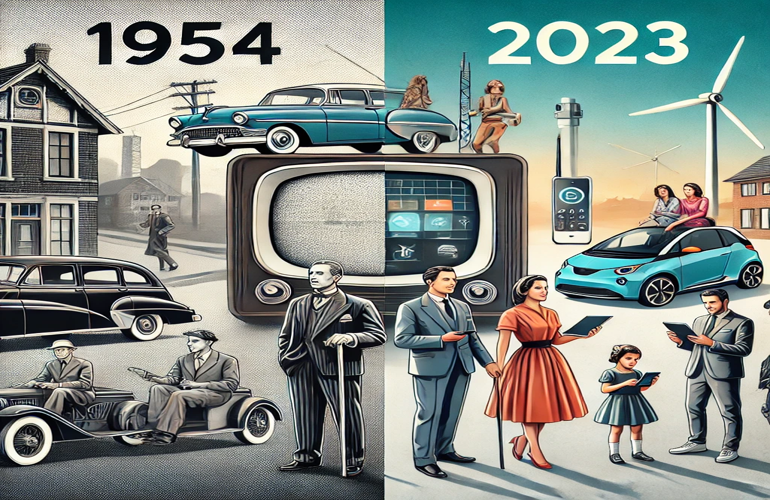
The years 2023 and 1954 mark significant points in history, each shaping the world in unique ways. From technological breakthroughs to cultural revolutions, these years serve as milestones that highlight progress and change. In this article, we will explore the major events, innovations, and societal shifts that define these years. By examining these key aspects, we aim to understand how the past influences the present and future. Join us as we journey through time, comparing the lifestyles, technological advancements, and cultural shifts between 1954 and 2023. This exploration offers insights into how far we’ve come and what lies ahead.
Historical Context
Post-World War II Recovery
The aftermath of World War II saw nations around the globe grappling with reconstruction and recovery. The 1950s, including the year 1954, were marked by efforts to rebuild economies, infrastructures, and social systems. Europe, heavily devastated by the war, received aid through initiatives like the Marshall Plan, which aimed to rejuvenate its economic landscape. This period also witnessed significant political changes, with former colonies gaining independence and reshaping the global political map.

Political Landscape
The early 1950s were dominated by the burgeoning Cold War between the United States and the Soviet Union. This era saw the establishment of NATO in 1949 as a collective defense pact against the perceived threat of Soviet expansion. By 1954, the geopolitical tension had solidified, influencing global politics and leading to numerous proxy wars and conflicts. The Korean War (1950-1953) was a direct result of these tensions, ending in an armistice that divided Korea into North and South, a division that persists today.
Technological Advancements
1954 marked a significant year in technological progress, particularly with the invention of the transistor. This innovation revolutionized electronics, paving the way for modern computing. Another landmark event was the beginning of space exploration. Although Sputnik, the first artificial satellite, would not be launched until 1957, the groundwork for space technology was being laid during this period. Television also evolved rapidly, becoming a staple in households and a major medium for entertainment and information dissemination.
Cultural Shifts
The 1950s experienced profound cultural shifts, particularly in the United States. The rise of civil rights movements began to challenge racial segregation and discrimination, setting the stage for major societal changes in the following decades. Music and film also underwent transformation, with rock ‘n’ roll gaining popularity and Hollywood producing iconic films that reflected and influenced social attitudes. Prominent cultural icons, such as Elvis Presley and Marilyn Monroe, emerged during this time, leaving a lasting impact on popular culture.
Major Events from 1954 to 2023
Over the decades following 1954, the world witnessed numerous pivotal events. Each decade brought its own set of challenges and advancements:
- 1960s: The civil rights movement in the U.S., the Vietnam War, and the space race culminating in the moon landing.
- 1970s: The rise of environmental awareness, the Watergate scandal, and significant technological innovations like the personal computer.
- 1980s: The fall of the Berlin Wall, the end of the Cold War, and the advent of the internet and networking technologies.
- 1990s: The dot-com era, significant advancements in digital technology, and the beginning of globalization.
- 2000s: The impact of 9/11, the rise of social media, and the proliferation of mobile technology.
- 2010s: Major advancements in artificial intelligence, the rise of big data, and significant social movements advocating for equality and justice.
- 2020s: Rapid developments in quantum computing, ongoing challenges related to climate change, and the global impact of the COVID-19 pandemic.
Influence of Historical Events on Present Day
The historical events and advancements from 1954 onwards have shaped the present in profound ways. The technological innovations laid the foundation for the digital age, transforming how we communicate, work, and live. Social movements from the past continue to influence contemporary efforts toward equality and justice. Understanding these historical contexts helps us grasp the complexities of today’s world and the continuous evolution driven by past experiences and achievements.
Technological Advancements
1954: The Dawn of the Computer Age
1954 marks an era when the foundation for modern computing was established. The invention of the transistor in the late 1940s had already revolutionized electronics, and by 1954, this technology was being harnessed to develop more sophisticated and compact electronic devices. This period saw the early stages of computer development, transitioning from bulky vacuum tubes to more efficient and reliable transistors, significantly impacting the evolution of computing technology.
Key Technological Milestones Across the Decades
1960s: The Rise of Silicon Valley
The 1960s were pivotal for the tech industry, with the establishment of Silicon Valley as a hub for innovation. This decade witnessed the creation of integrated circuits, which laid the groundwork for the miniaturization of electronic components. Companies like Intel emerged, setting the stage for future technological revolutions.
1970s: The Personal Computer Revolution
The 1970s brought the personal computer into homes and businesses. Innovations such as the Altair 8800 and Apple’s early computers made computing accessible to the general public. This era also saw the development of programming languages and software that empowered users to harness the power of computers for various applications.
1980s: The Internet and Networking Boom
The 1980s were characterized by the rise of networking technologies and the early stages of the internet. The introduction of Ethernet and the development of TCP/IP protocols allowed computers to connect and communicate, leading to the creation of early networks. The launch of ARPANET, a precursor to the modern internet, revolutionized how information was shared and accessed.
1990s: The Dot-Com Era
The 1990s saw the internet’s rapid expansion, with the dot-com boom driving significant investment and innovation. Web browsers like Netscape Navigator and search engines like Google transformed how people accessed and consumed information. E-commerce platforms emerged, changing the landscape of retail and business.
2000s: The Mobile Revolution and Social Media
The early 2000s marked the advent of mobile technology with the introduction of smartphones. Devices like the iPhone revolutionized communication, providing internet access, multimedia capabilities, and a platform for countless applications. Social media platforms such as Facebook, Twitter, and Instagram changed how people interacted and shared their lives online.
2010s: The Age of Artificial Intelligence and Big Data
The 2010s were defined by significant advancements in artificial intelligence and data analytics. Machine learning algorithms and big data analytics transformed industries, from healthcare to finance. AI-powered applications like virtual assistants and recommendation systems became integral parts of daily life.
2020s: The Quantum Leap and Beyond
The current decade is witnessing breakthroughs in quantum computing, promising to solve complex problems beyond the reach of classical computers. Advances in areas like quantum encryption and quantum simulations are opening new frontiers in technology. This period also sees continuous improvements in AI, robotics, and biotechnology, driving innovation across various fields.
Impact of These Advancements on Society
The technological progress from 1954 to the present has profoundly impacted society. Early computing innovations paved the way for the digital age, transforming industries, economies, and daily life. Networking technologies revolutionized communication, breaking down geographical barriers and fostering global connectivity. The internet’s rise enabled the information age, making knowledge more accessible and driving e-commerce and digital services.
The mobile revolution brought unprecedented convenience, allowing people to stay connected and access information on the go. Social media reshaped social interactions, influencing culture, politics, and personal relationships. AI and big data have optimized processes, enhanced decision-making, and personalized user experiences across various sectors.
Cultural Shifts and Influential Figures
Cultural Shifts
Civil Rights Movements
The 1950s saw the beginnings of significant civil rights movements, especially in the United States. The push for equality and justice began to gain momentum with events like the Brown v. Board of Education decision in 1954, which declared racial segregation in public schools unconstitutional. This era set the stage for the more extensive civil rights struggles of the 1960s, which led to landmark legislation and broader societal changes.
Music and Film Evolution
The mid-20th century also witnessed transformative changes in music and film. The rise of rock ‘n’ roll in the 1950s, with artists like Elvis Presley, challenged traditional norms and influenced youth culture globally. Movies became a powerful medium for storytelling and cultural expression, with Hollywood producing classics that reflected and shaped societal values.
Social Norms and Values
Over the decades, societal norms and values have continually evolved. The 1960s brought about a counterculture movement that questioned authority and traditional values, promoting ideas of freedom, peace, and love. The feminist movement gained strength, advocating for women’s rights and gender equality. Each subsequent decade saw further shifts, with the 1980s and 1990s introducing more liberal attitudes towards lifestyle choices, while the 2000s and 2010s emphasized inclusivity and diversity.
Influential Figures
Martin Luther King Jr.
A leading figure in the American civil rights movement, Martin Luther King Jr. advocated for nonviolent resistance and played a pivotal role in ending racial segregation and discrimination. His speeches, most notably the “I Have a Dream” speech, remain influential and continue to inspire movements for justice and equality worldwide.
Frida Kahlo
Mexican artist Frida Kahlo is renowned for her unique style and deeply personal paintings. Her work, often exploring themes of identity, postcolonialism, gender, and class, has left a lasting impact on art and culture. Kahlo’s legacy continues to inspire artists and activists who see her as a symbol of resilience and individuality.
Albert Einstein
Though his most groundbreaking work was in the early 20th century, Albert Einstein’s influence persisted through the mid-century and beyond. His theories of relativity revolutionized physics and had far-reaching implications for science and technology. Einstein also became a prominent public figure, advocating for peace and human rights.
Maya Angelou
An acclaimed poet, memoirist, and civil rights activist, Maya Angelou’s work has had a profound impact on literature and social justice. Her autobiographical works, particularly “I Know Why the Caged Bird Sings,” explore themes of identity, racism, and resilience, resonating with readers and inspiring generations.
Prominent Cultural Icons
Elvis Presley
Known as the “King of Rock ‘n’ Roll,” Elvis Presley became a cultural icon in the 1950s. His music, style, and charisma revolutionized the entertainment industry, influencing countless artists and shaping the future of rock music.
Marilyn Monroe
An emblematic figure of Hollywood, Marilyn Monroe became one of the most famous actresses of the 1950s and 60s. Her roles in films like “Some Like It Hot” and her public persona left an indelible mark on popular culture.
The Beatles
Emerging in the 1960s, The Beatles revolutionized music and popular culture. Their innovative music, style, and influence extended beyond their songs, impacting social movements and the cultural landscape of the time.
Evolution of Social Norms and Values
The past decades have seen a progressive shift towards more inclusive and diverse societal norms. Movements advocating for LGBTQ+ rights, gender equality, and racial justice have transformed legal frameworks and societal attitudes. Cultural representation in media has become more diverse, reflecting a broader range of experiences and stories.
Impact on Society and Future Predictions
Societal Shifts
Changing Lifestyles
The period from 1954 to 2023 has seen remarkable changes in daily life and societal norms. In the 1950s, life was characterized by a more rigid structure, with clear gender roles and a strong emphasis on traditional family values. By 2023, these roles have evolved significantly, influenced by the feminist movement, economic changes, and technological advancements. The advent of dual-income households, telecommuting, and the gig economy has reshaped the way people live and work.

Technological Integration
Technology has deeply integrated into daily life, altering how people interact, work, and entertain themselves. From the early days of television in the 1950s to the current era of smartphones and AI, technology has continuously redefined human interaction. Social media platforms have replaced many traditional forms of communication, while advancements in medical technology have increased life expectancy and improved quality of life.
Educational Evolution
Education has also undergone significant transformation. The 1950s educational system was more rigid and less inclusive, focusing primarily on rote learning. Today’s education emphasizes critical thinking, digital literacy, and inclusivity. Online education platforms and digital resources have made learning more accessible, enabling lifelong learning and continuous skill development.
Future Predictions
Technological Advancements
Looking ahead, technology is expected to continue evolving at a rapid pace. Quantum computing, advanced AI, and biotechnology promise to bring about unprecedented changes. These advancements could revolutionize fields such as medicine, climate science, and information technology, addressing some of the most pressing global challenges.
Work and Economy
The future of work is likely to be increasingly digital and flexible. Remote work, augmented by advancements in virtual reality and AI, may become the norm, reducing the need for traditional office spaces. This shift could lead to a more balanced work-life dynamic and open up job opportunities across geographic boundaries.
Social and Cultural Trends
Culturally, there may be a continued push towards inclusivity and diversity. Social movements advocating for equal rights and representation are expected to gain further traction. Additionally, cultural exchanges facilitated by global connectivity might lead to a more blended and enriched global culture.
Environmental Considerations
Environmental sustainability will be a major focus in the coming decades. Innovations in renewable energy, sustainable agriculture, and conservation efforts are critical to addressing climate change. Societies are likely to adopt greener practices, driven by both policy changes and public awareness.
Healthcare Evolution
Healthcare is poised for significant advancements with the integration of AI and personalized medicine. Predictive analytics could lead to earlier diagnosis and better treatment outcomes, while advancements in biotechnology might bring about cures for currently incurable diseases. The focus on mental health is also expected to grow, recognizing its importance alongside physical health.
Long-Term Effects on Society
Global Connectivity
The increased global connectivity fostered by technological advancements will continue to influence economic, cultural, and social dynamics. This connectivity could lead to greater collaboration and innovation but might also present challenges related to data privacy and cybersecurity.
Cultural Preservation and Change
While globalization can lead to cultural homogenization, there is also a strong movement towards preserving cultural heritage. Efforts to document and celebrate diverse cultural traditions are likely to intensify, ensuring that these traditions are not lost in the face of rapid modernization.
Political and Economic Structures
Political and economic systems may also see significant changes. The rise of digital currencies and decentralized finance could transform traditional financial systems. Political landscapes might shift as societies demand greater transparency and accountability from their leaders, influenced by the widespread availability of information and the power of social media.
Lessons Learned from the Past
Political and Diplomatic Lessons
Avoidance of Large-Scale Conflicts
The mid-20th century witnessed devastating global conflicts, primarily World War II. From these events, the importance of diplomacy and international cooperation became clear. Institutions like the United Nations and treaties such as NATO were established to foster peace and prevent future large-scale wars. These efforts underline the necessity of dialogue and collaboration to resolve disputes and maintain global stability.
Cold War Dynamics
The Cold War era taught valuable lessons about the risks of ideological polarization and arms races. The prolonged standoff between the United States and the Soviet Union highlighted the dangers of mutual distrust and the benefits of strategic arms reduction agreements. This period also demonstrated the importance of soft power and cultural diplomacy in influencing global public opinion and achieving geopolitical goals without direct conflict.
Technological Progress and Its Implications
Innovation Driving Economic Growth
The technological advancements from the transistor to the internet have shown how innovation can drive economic growth and development. Each wave of technological progress, from the personal computer to smartphones and AI, has created new industries, jobs, and opportunities. This underscores the need for continuous investment in research and development to stay at the forefront of global technological trends.
Balancing Innovation with Ethical Considerations
Technological progress also brings ethical challenges. The development of nuclear technology, for example, highlighted the need for ethical frameworks to manage powerful innovations responsibly. In recent times, AI and data privacy issues remind us that technological advancement must be balanced with considerations of privacy, security, and ethical use.
Cultural and Social Insights
Civil Rights Movements
The civil rights movements of the 1950s and 1960s demonstrated the power of grassroots activism and the importance of fighting for equality and justice. These movements have left a lasting legacy, influencing contemporary struggles for racial, gender, and LGBTQ+ rights. They highlight the ongoing need for vigilance and activism to achieve social progress.
Cultural Resilience and Adaptation
Cultural shifts over the decades have shown how societies adapt and evolve. The blending of cultures through globalization has enriched societies but also posed challenges in preserving unique cultural identities. The resilience of cultural traditions amid change emphasizes the importance of valuing and maintaining cultural heritage.
Reflections on 2023-1954
Technology as a Double-Edged Sword
The period from 1954 to 2023 has underscored that while technology can enhance lives and drive progress, it also comes with potential downsides such as job displacement, privacy concerns, and environmental impact. Understanding these dualities helps in creating policies that maximize benefits while mitigating risks.

Importance of Education and Lifelong Learning
The rapid pace of change has highlighted the importance of education and the need for lifelong learning. Keeping up with technological advancements and societal shifts requires continuous learning and adaptation. This lesson stresses the need for educational systems that are flexible and forward-thinking.
Global Interconnectedness
The increasing interconnectedness of the world, driven by technological and cultural exchanges, has shown that global challenges require collective solutions. Issues like climate change, pandemics, and economic instability cannot be addressed by individual nations alone. This period teaches the importance of global cooperation and collective action.
Long-Term Impacts on Global Politics
Geopolitical Shifts
The decline of colonial empires and the rise of new global powers have reshaped international relations. Understanding these shifts helps in anticipating future geopolitical trends and preparing for changes in global power dynamics.
Continued Relevance of Historical Alliances
Alliances formed in the mid-20th century, such as NATO, remain relevant. Their evolution shows the importance of maintaining and adapting strategic partnerships to address contemporary security challenges.
Ongoing Influence of Cultural Changes
Role of Media and Communication
The evolution of media from print and broadcast to digital and social media has transformed how information is disseminated and consumed. This ongoing change underscores the power of media in shaping public opinion and cultural norms.
Social Movements and Activism
The legacy of past social movements continues to inspire contemporary activism. The methods and strategies developed during earlier struggles for justice and equality are being adapted to modern contexts, showing the enduring impact of these movements.
Conclusion
The years between 1954 and 2023 illustrate a journey of profound transformation. From early technological breakthroughs to the digital age, and from rigid societal norms to a more inclusive world, each decade has contributed to shaping our current landscape. Technological advancements have driven economic growth and altered lifestyles, while cultural shifts have redefined social values. Political and historical events have highlighted the importance of diplomacy, cooperation, and ethical governance. As we reflect on these changes, the lessons learned guide us in navigating future challenges and opportunities. This period reminds us that progress is a continuous process, built on the foundations of past experiences and innovations.
FAQs
1. What were the major technological advancements between 1954 and 2023?
Major technological advancements include the invention of the transistor, the rise of personal computers, the development of the internet, the advent of mobile technology, and recent breakthroughs in artificial intelligence and quantum computing.
2. How did societal norms and values change from 1954 to 2023?
Societal norms and values shifted significantly, with movements for civil rights, gender equality, and LGBTQ+ rights. These changes led to a more inclusive and diverse society, challenging traditional roles and promoting greater acceptance and representation.
3. What were some significant political events during this period?
Key political events include the Cold War and its eventual end, the establishment and evolution of NATO, the civil rights movements in the United States, the fall of the Berlin Wall, and the rise of new global powers.
4. How did cultural shifts impact daily life over these decades?
Cultural shifts, such as the rise of rock ‘n’ roll, the influence of Hollywood, and the impact of social media, transformed entertainment, communication, and social interactions. These shifts have continually redefined what is considered mainstream and acceptable in society.
5. What lessons can be learned from the historical events of 1954 to 2023?
Lessons include the importance of diplomacy and international cooperation to prevent conflicts, the need for ethical considerations in technological advancements, and the power of grassroots movements in achieving social change. These lessons highlight the ongoing relevance of historical experiences in addressing current and future challenges.







